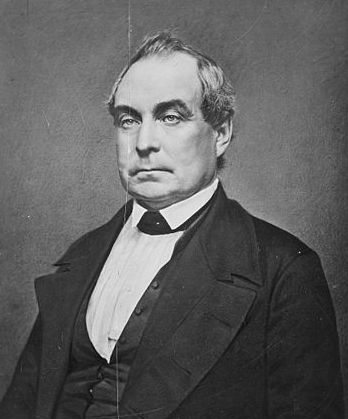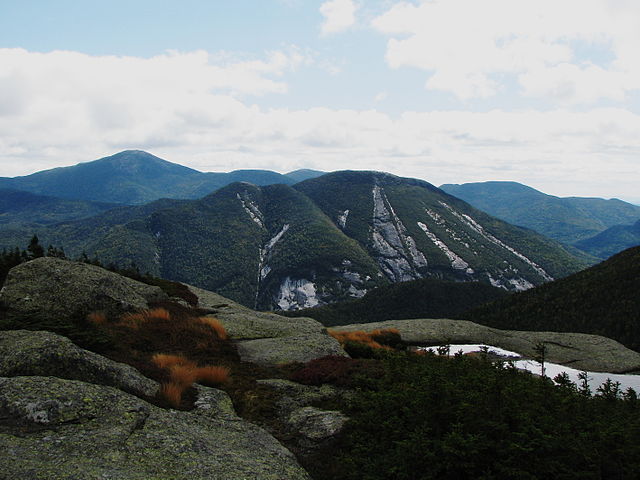
Silas Wright. Circa 1860. Source: National Archives and Records Administration.
Silas Wright was born in Massachusetts in 1795, but his family moved to Weybridge two years later where they established a farm. He was sent to school in Middlebury to prepare for college, but was so shy that he skipped school often to avoid having to recite Latin before his class and begged his father to let him drop out of school and work on the family farm. His father refused, and Wright continued his education at Middlebury College, where he studied at the same time as his childhood friend Edwin James. [ref] Washington, History of Weybridge, Vermont. [/ref] At Middlebury, he was “distinguished for moral honesty and for an unbending regard to the truth.” [ref] Gillet, The Life and Times of Silas Wright. [/ref] After graduating, Wright pursued a career in Law, studying in Albany and settling in Canton, New York, in 1819. Shortly after moving to Canton he began a successful political career, serving in the State Senate in 1823 for four years, then as a representative in the United States Congress for two years, and later as a United States Senator for eleven years. [ref] Washington, History of Weybridge, Vermont. [/ref] He was widely respected, and one biographer notes that he was characteristically seen as “ the good public servant who thought first of the welfare of the many and who never thought much of his own affairs; for the public, he thought well and achieved many valuable things.” [ref] Chancellor, A Life of Silas Wright 1795-1847, United States Senator from New York 1833-1844, Governor of the State of New York 1844-1846. [/ref] Despite his childhood anxiety for public speaking, he became known “for his effectiveness as a speaker and his calmness in the heat of debate.” [ref] Washington, History of Weybridge, Vermont. [/ref]
After his term in the Senate, he returned to New York and was—despite his own humble reluctance—elected Governor for one term. In fact, he asked his supporters in New York specifically “not to nominate him, but he won the nomination anyway.” Wright once said, ““The office should seek the man, not man the office,” which indeed reflected his own political career. He focused on issues relate to taxation and economic policies, but he also considered himself firmly opposed to slavery. However, unlike the later North County newcomer John Brown, “he was also against inciting war to abolish it, remaining true to his statement, ‘Wrong acts never serve a good cause.’” [ref] Chancellor, A Life of Silas Wright. [/ref] Wright was even nominated as James K. Polk’s running mate in the Presidential election of 1844, but immediately declined the offer. [ref] Washington, History of Weybridge, Vermont. [/ref] Some have even remarked that he possessed the “largeness of life suitable in a President,” [ref] Chancellor, A Life of Silas Wright. [/ref] but rather than pursuing loftier political ambitions he returned to Canton, where he died in 1847.
Silas Wright, known upon his death as a “simple man of great integrity with a desire to serve the public,” [ref] Adirondack Forty-Sixers, Inc., Heaven Up-H’isted-Ness. [/ref] was recognized in his hometown with a marble monument completed in 1850 which still sits on Weybridge Hill, funded by donations from the community. [ref] Washington, History of Weybridge, Vermont. [/ref] Former President Martin van Buren—who was also a close friend of Wright’s—came to speak at the monument’s dedication, among others. [ref] Gillet, The Life and Times of Silas Wright. [/ref] In 1873, surveyor Verplanck Colvin named the northernmost peak in the Adirondacks’ MacIntyre range in his honor as Wright Peak, for he “was indeed a representative of the northern region, and [his] own St. Lawrence County may be looked upon from the summit of this vast granite monument.” [ref] Colvin, Annual Report on the Progress of the Topographical Survey of the Adirondack Region of New York. [/ref] Today, Wright Peak is among the most popular destinations in the Adirondack Park. Its exposed summit is one of several in the state which is home to an Arctic-alpine plant community, and the wreckage of a Cold War-era bomber remains just below the summit. [ref] Adirondack Forty-Sixers, Inc., Heaven Up-H’isted-Ness. [/ref]

View from Wright Peak. Source: https://commons.wikimedia.org/wiki/File:Mount_Colden_from_Wright_Peak.jpg.